Summer IT-schools in Yakutia: how it is done
Good afternoon friends! Today I will tell you how we participated in the organization of 2-year IT-schools in the Republic of Sakha (Yakutia) and what came of it. Welcome under cat.
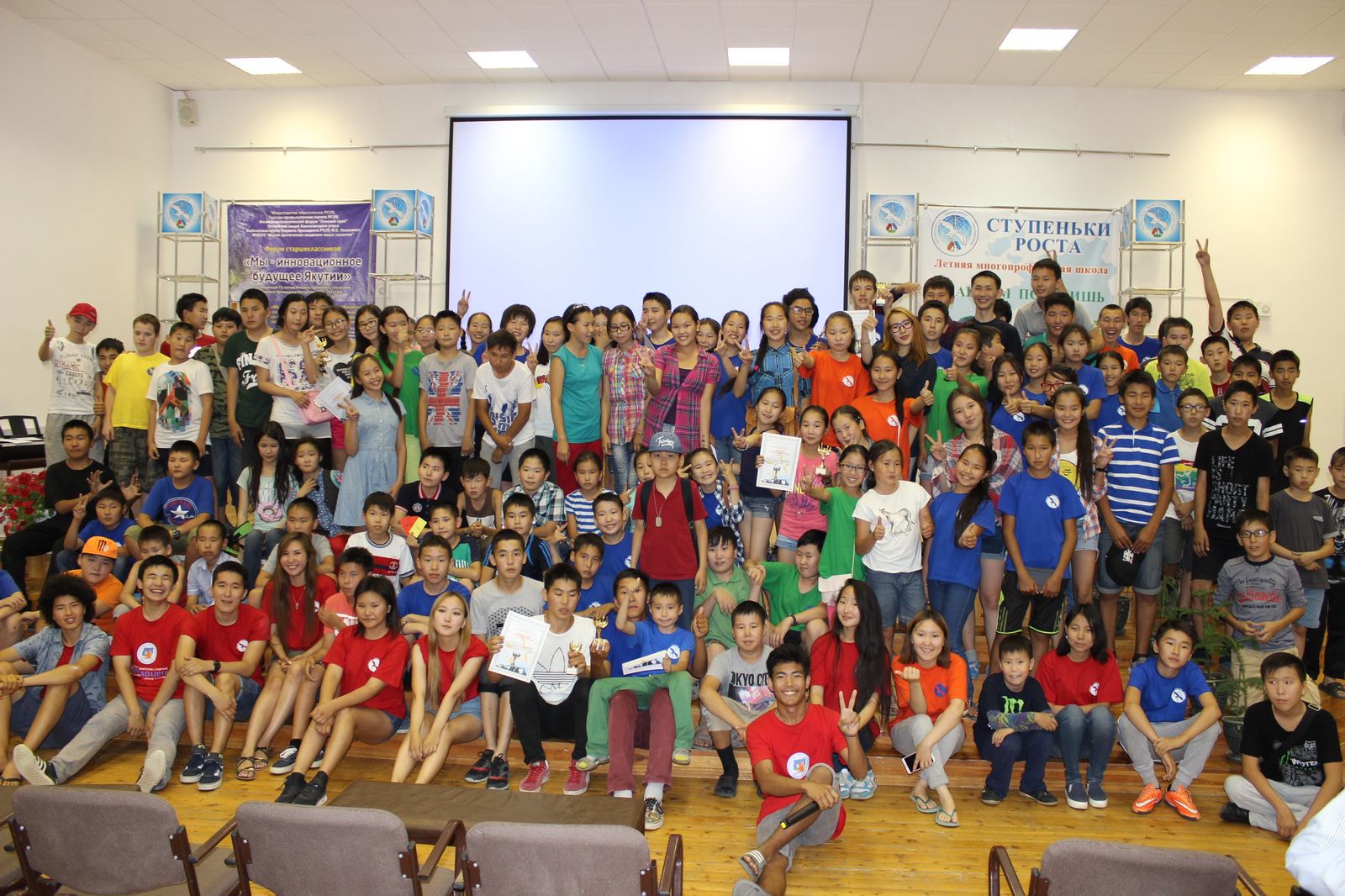
It so happened that the team of our company is not the first time taking part in the conduct of IT-schools in various parts of our country. Our cooperation with Yakut lyceums and technoparks in the form in which it is proceeding now began last summer with conducting robotics classes at the Summer Physics and Mathematics School “Creating the Future”, which was held at the Lensky Krai forum in the village of Oktemtsy, Khangalassky district. I have already prepared a publication about it and can read it here: Summer School of Innovative Projects “Creating the Future”: how it was .
This year we had the opportunity to participate in the conduct of two schools for robotics in 2 regions of Yakutia: in Khangalassky ulus and Amga. Next, I will tell you how they were organized, who we are and how we relate to these schools. Sit back - we begin.
This school is traditionally held every year in the small homeland of the First President of the Republic of Sakha (Yakutia) - in the village of Oktemtsy of the Khangalassky district. However, until this year, this school was conducted only on the basis of the Lensky Krai forum, which was entirely responsible for the conduct and organization of this school. In the same year, by decree of Nikolaev Mikhail Efimovich, the school was organized right away at 3 sites located in Oktemtsy: at the forum “Lena Krai”, based on the technopark of Oktemsky lyceum and with the support of the funds of the library of the republican museum of the First President of the Republic - Nikolaev M. Since this year we were invited not by the forum, but by the Oktemsky technopark, and worked mainly in it, I will most fully describe what happened in the technopark, but I will also try to highlight the events occurring in the remaining areas School culture beds, but what I can delete or highlight not quite the way it was in fact, so I apologize in advance for that.
A little about us and why we are so good :)
This year, 2 people drove us to the summer schools: the research manager of the RobotGeeks company, he is the associate professor of the Robotic Systems and Mechatronics department at the Bauman Moscow State Technical University — Vorotnikov Sergey Anatolyevich, and I, the author of this publication, Panfilov Alexey Olegovich. The two of us, not the first time working in tandem, achieved quite good results, primarily due to a real understanding of each other's capabilities and skills - S. Vorotnikov. I was primarily engaged in methodological work, reading theoretical lectures and leading the research part of the projects being carried out, and I was responsible for all the technical part and practical training. Everything was as usual here. Our coordinator at the School was Alekseeva Marina Petrovna - the head of the Oktem technopark and just a wonderful person.
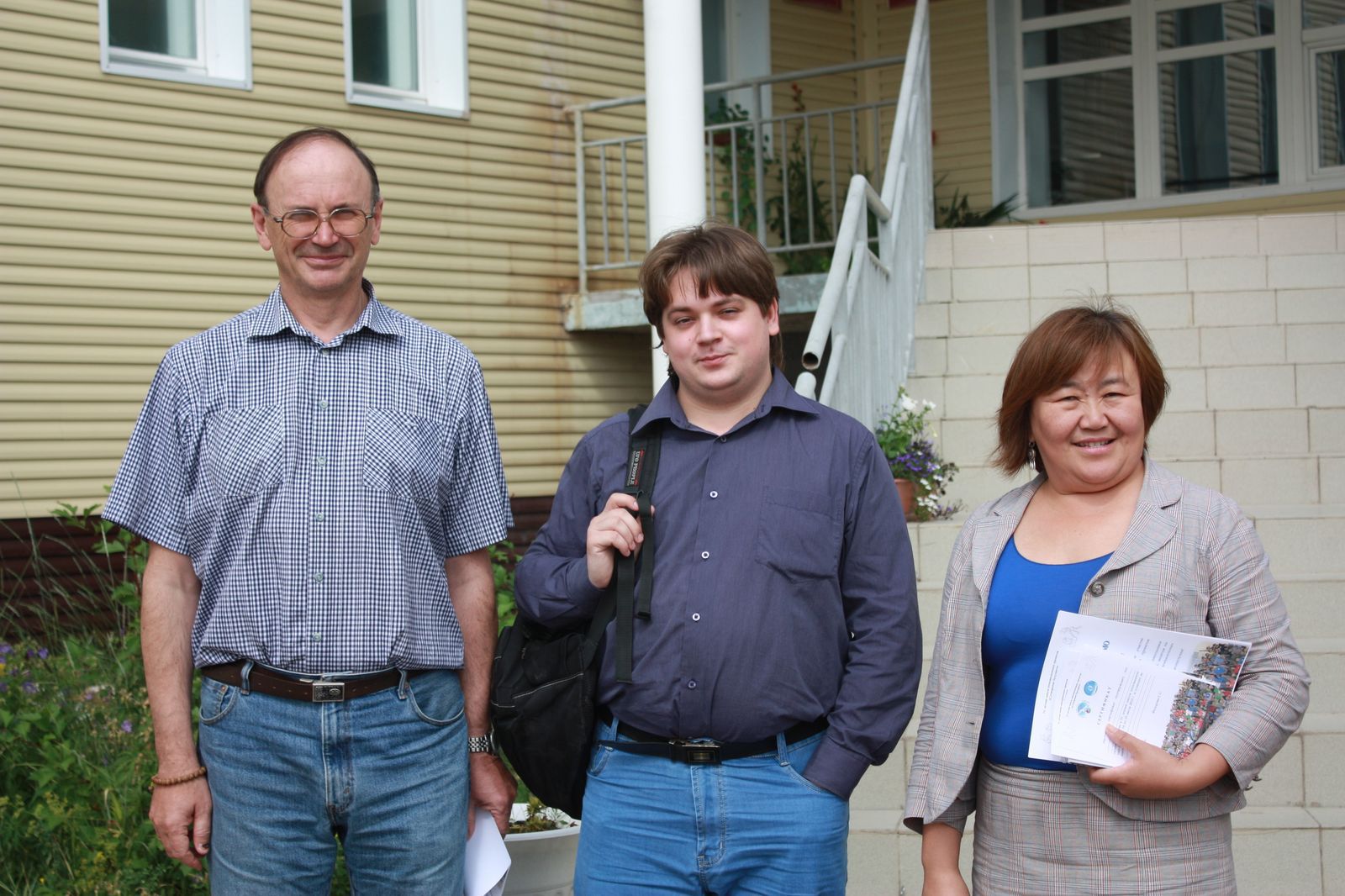
Our top top team
')
How it all began and arranged.
I described my feelings about the state of the central part of Yakutia and the roads along which we had to get to the School venue in the first article. I haven’t yet seen anything new on this summer visit. But this is only for now. This year’s accommodation, unlike the previous year, was carried out in a lyceum hotel, which corresponds to about 3 stars in level, which for us, not very spoiled by Muscovites, was pleasant, but not very necessary (last time we lived in a shared hostel for students, which, by the way is much better than typical student hostels of Moscow). Food for us throughout the School was carried out on the basis of the Lyceum's boarding school, where students of the lyceum live throughout the year, but on a strict schedule - 8.00 - breakfast, 13.00 - lunch, 18.00 - dinner, 21.30 - late dinner. The feeding level was quite decent. We were pleased. I would like to separately note the fact that the entire contingent of participants was conditionally divided into 2 parts: "forum" and "lyceum", which resulted in a certain disunity in terms of organization, which in turn affected the division in terms of accommodation of participants and organization of their meals . "Lyceum" lived in a lyceum boarding school and ate there, "forum" lived in a forum hostel, and ate in a forum canteen. Such a division of participants contributed to the division into specializations, primarily focusing on areas of interest to the lyceum, however, as practice has shown, the coordination of issues relating to the organization of the educational and everyday process caused difficulties, but since MP Alekseeva dealt with these issues. they weren’t very worried about us, but until such time as this disunity did not affect our educational process. First of all, this influence was exerted by the lack of discipline at events common to all: the children roared, walked back and forth, generally doing everything they wanted, just not what they had to do. Having expressed our dissatisfaction with the lack of organization in terms of discipline, we were surprised to find the division of forum and lyceum organizers into 2 sides: forum ones believed that everything was normal, but lyceum tried to fix something. In general, as usual, a consensus could not be reached, well, okay. As I have already said, we worked mainly in a technopark, where everything was fine with discipline, and we could endure one-off events for all.
What did the children at school do?
First, a little about the children. Since LSIP has the status of a republican school, children gathered for it from all over the republic and even from Yakutsk itself. In total, more than 70 schoolchildren from the 4th to the 11th grade participated in the School this year. So the contingent was very diverse. As I said earlier, this year 3 sites were immediately involved in which school events were held. Also, the integration of forum resources and technopark resources in terms of technical equipment and the territory made it possible to organize as many as 7 directions in which children could engage. However, since the contingent was motley, within certain directions, there was a division into conditional subgroups, thus allowing the guys with different levels of training to do what was interesting to them. As a result, 10 groups were organized, each of which involved a separate teacher or 2 teachers at once, for example, as in our case. Heads of directions were invited mainly from leading schools and universities of Yakutia, therefore students were engaged with some groups. Since the main condition for studying at the School was to protect their own project (protection was allowed in small groups), within each group the children were divided into subgroups to carry out their project. But there were those who carried out their project alone. Now I will tell you more about each of the directions.
1. Designing Android applications.
As part of this direction, participants were offered to get acquainted with the Android Studio environment, to try to program on JS, and as a result to go out with their application to protect. Classes with schoolchildren were conducted by V.N. Pesterev, a student at the Institute of Physics and Technology at NEFU, and Borisov, V., a researcher at the Institute at NEFU. As part of this direction, 5 projects were completed - in fact, 5 simple applications were written, the most interesting of which, in my opinion, were the GPS tracker, and the game Right-Wrong.
2. 3D modeling
The students who chose this direction were trained to work in 3D Max, and again the direction was divided into 2 groups, with which Yakovlev AV, the computer science teacher from the Yakutsk Cadet School, and Petrova EA, the senior teacher of the Institute of NEFU, were engaged.
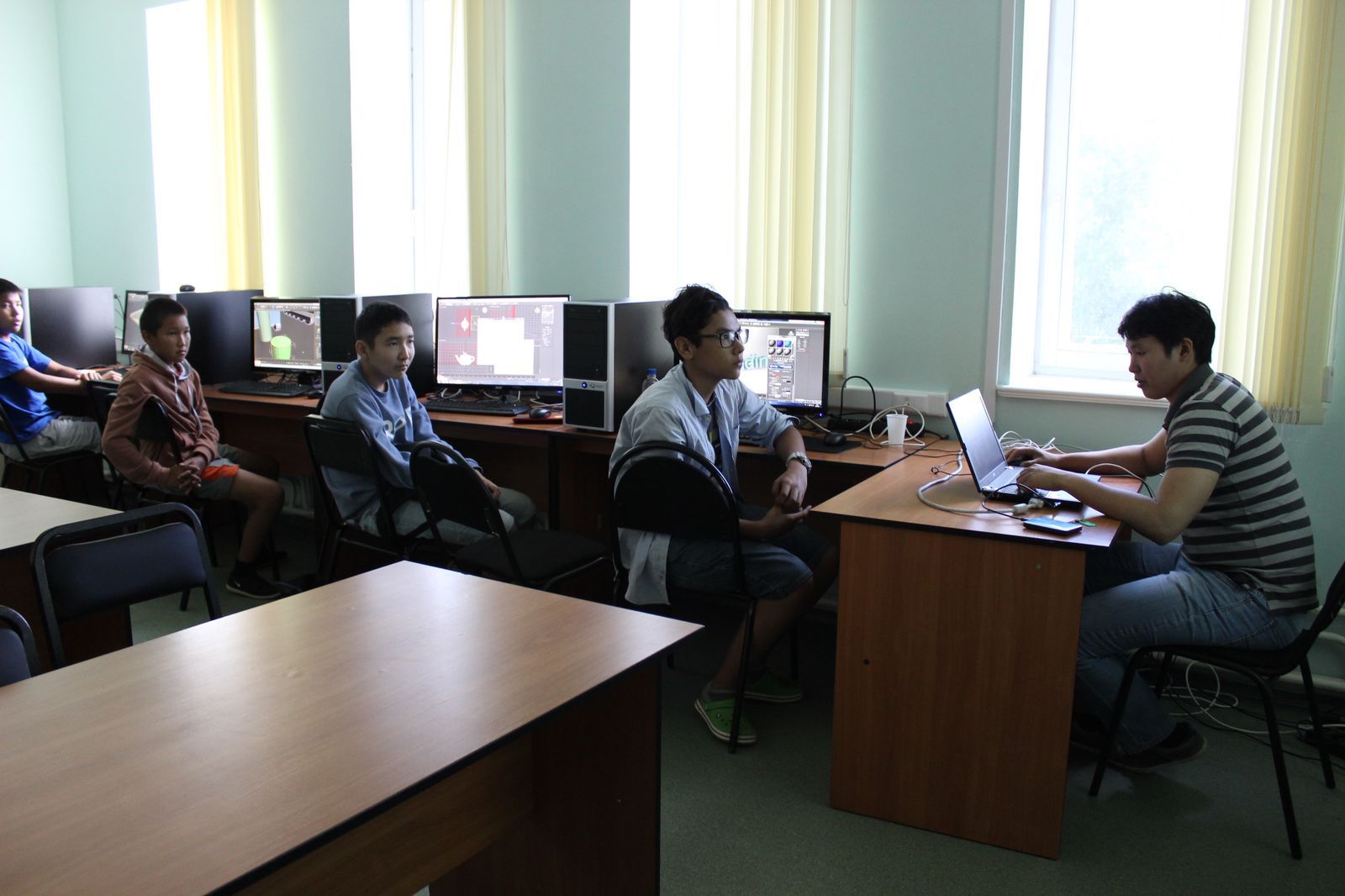
In this area, the guys have implemented a number of their ideas, which consist in modeling various objects and structures. From my point of view, despite the fact that some models looked very cool (for example, a tank model with very cool details), all projects clearly lacked an idea why and why these models are being made. Therefore, it is difficult to call what students did the project activity in the classical sense of the word “project”. As a result, this turned out to be a good master class in teaching Mah's work in 3D, but not as managing his project.
3. Designing is not the basis of unusual laws of physics.
Despite the not quite clear name, the essence of the work in this direction was reduced to experimental physics / chemistry, in the framework of which the guys conducted a series of experiments and suggested creative ideas for applying some interesting properties of unusual materials in our life. The result of the work of this direction were 4 projects:
- Clear evidence of harm Coca Cola

- Production of electricity using water flow forces
- Architectural bionics
- Non-Newtonian liquid to cover road holes.
The head of all these projects was Sharaborin E.L. from Moscow Physics and Technology Institute.

4. Lego Mindstorms
Well, where in our time of development of educational robotics without Lego. In this direction, the youngest participants of the School mostly rushed, but there were also enough older ones. All the projects implemented in this direction were fairly typical for Leg'ovskiy kits - either something is going somewhere slowly, or something is standing still and moving.

This time they were supervised by Sveshnikova L.M., a computer science teacher from NGL and Prokopyev EV, a computer science teacher from Ozhulunskaya Secondary School. From my point of view, the only non-trivial project presented in this direction was the project of smart housing lighting, primarily because within its framework an unconventional look at the Lego designers was made. It is a pity that such a solution can only act as a model, when, as the implementation of such a project on arduino, would bring a much greater profit.
5. Creative Robotics + English
The most exotic direction of all. First of all, thanks to his supervisor - the local African American Michael. The youngest members of the School in this area studied English, made simple robots and filmed a film with their participation. It all looked very unusual, entertaining and very exotic.
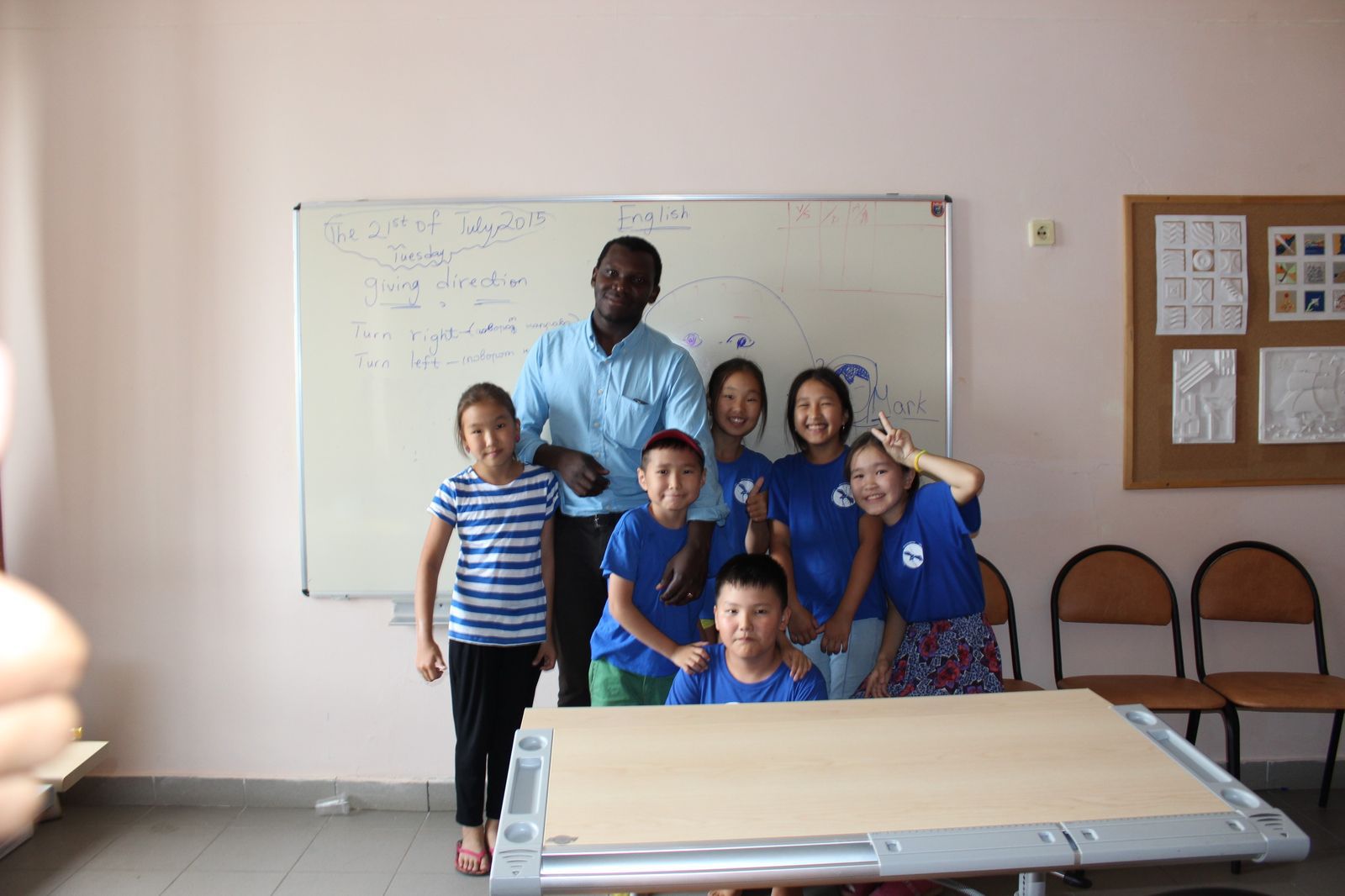
6. Innovative site
The idea of an innovative site was born in the spring, when the spring irrigation school of robotics was implemented the project of an automatic irrigation system on the arduino hardware platform. At this summer school, it was decided to try to implement this project in real life and use it for automatic watering of flowerbeds with flowers, broken near the school technopark.
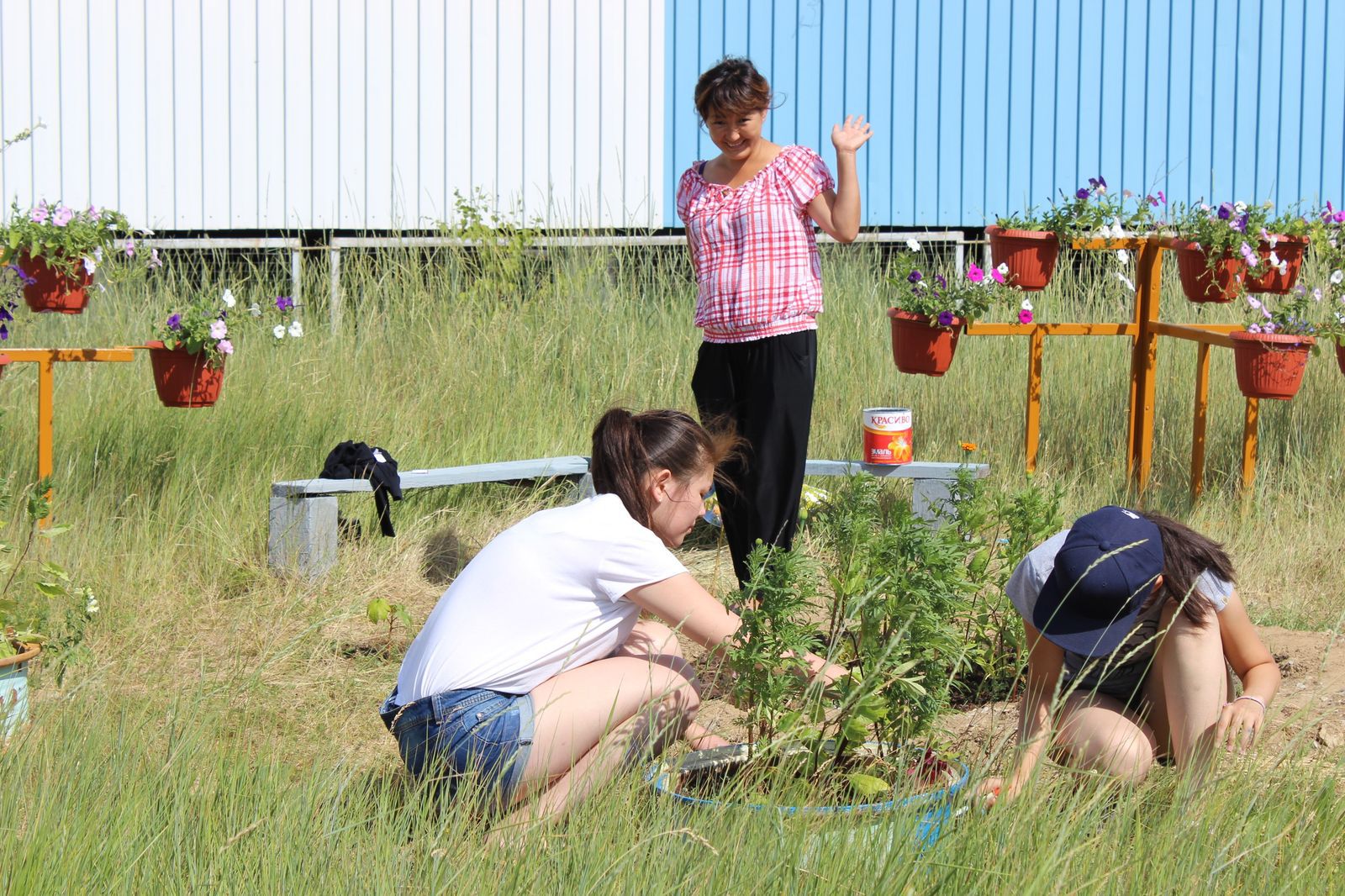
7. Design of autonomous robotic systems
The most "adult" and the most serious direction in the framework of the School. Only iron, only hardcore. The smell of rosin and burned components. Of the participants - only students 10-11th classes. From the equipment - all they could find. And we found a lot: 3 VEX constructors, 4 Bioloid Stem sets, 1 Bioloid Premium , a bunch of Arduino hardware platforms, an uncountable number of different sensors and modules for arduino and, of course, electrical tape. It is a pity that not blue. And all this wealth for 5 people. Yes, we had a total of 5 participants and each made their own individual project.

Since the 3rd participants are not the first time they attend our schools of robotics in Yakutia, I ventured to allow everyone to work separately from each other and with full immersion. Full immersion was expressed in the following:
- Separate, the largest audience of the Okteme technopark was allocated to us. We did not bother about the working space - used the place as much as we needed.
- Work began at 9.30 am every day and ended at 6 pm. Lunch break - 1.5 hours. Those interested also came to work out after dinner in addition - from 19.00 to 21-22 hours. And so for 7 days in a row.
- Despite the fact that in Yakutia, in principle, with the trouble of the Internet, we had organized access to the Internet at speeds up to 128 Kb / s.
In general, the conditions for work were gorgeous. And all this resulted in 5 completed projects:
1. Multicomponent mechatronic system with elements of technical vision. Completed: Kapitonov Maria

In fact, this is a robotic arm assembled from Dynamixel servo drives from the Bioloid Premium designer. A feature of the project is the presence of the image recognition module HaViMo2.0, capable of recognizing hand gestures that it sees. As an example, a stone-paper-scissors game was demonstrated, in which the robot won with about 70-80% probability.
2. Two-component system of access control to the protected premises. Fulfilled: Leonid Kondratiev
Using an RFID reader, a laser module, a pair of servo drives and a handful of LEDs, Leonid using a hardware platform Arduino made a door model with a two-component access control system, and writing a script for which the object has / does not have the right to pass through the door, it’s very effective like in the movies". The very layout of the door was assembled from elements of the VEX designer.

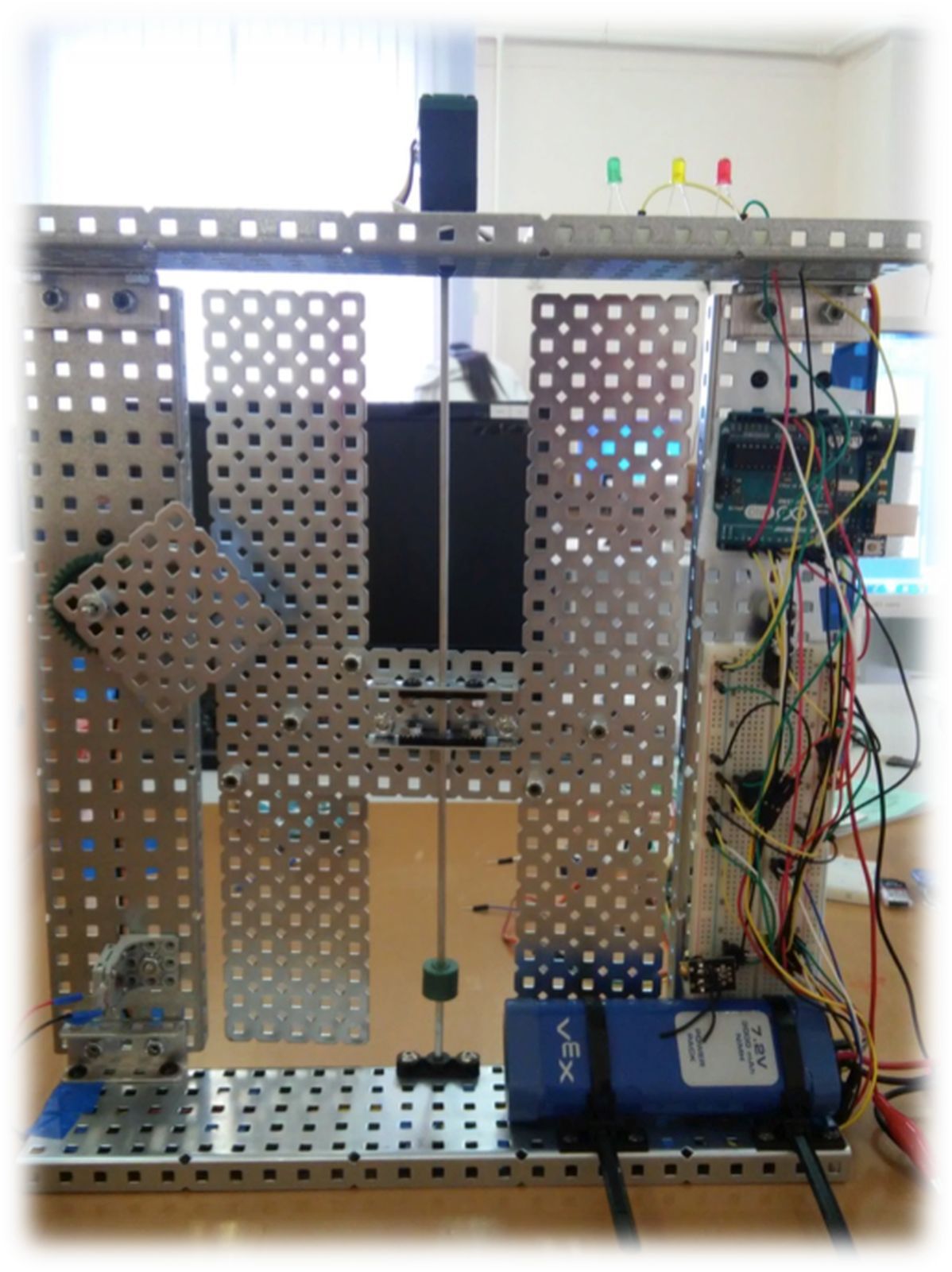
3. Robot firefighter. Fulfilled: Ushnitsky Daniel
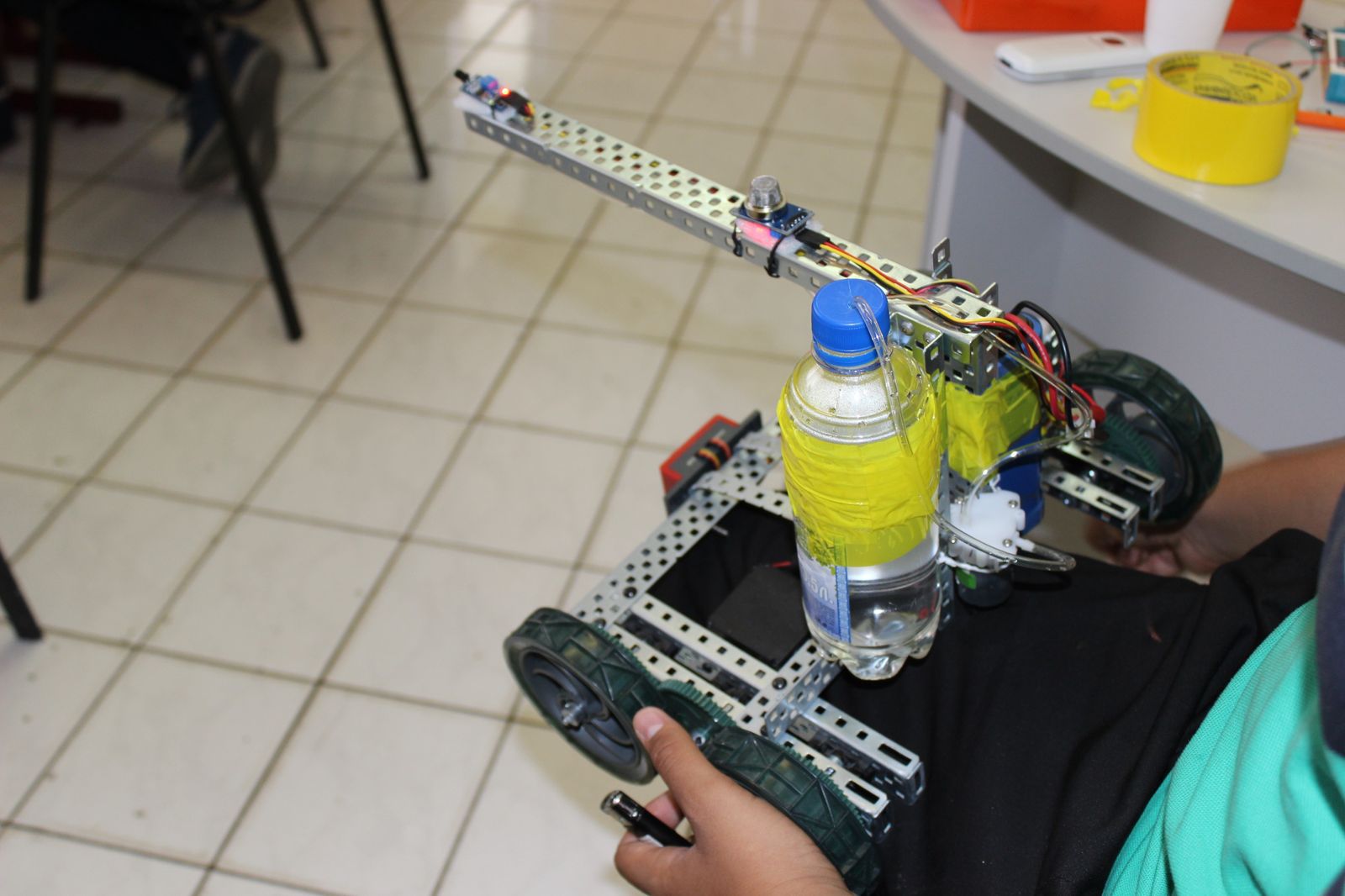
Using one of the simplest and most affordable VEX-CLAWBOT kits, Daniel made a firefighter robot able to analyze the surrounding air for smoke, if smoke is detected, go on a search for fire and extinguish it with a micropump if it is detected using the available water supply.
4. Control the robot via Wi-Fi. Fulfilled: Kipriyanov Glory.
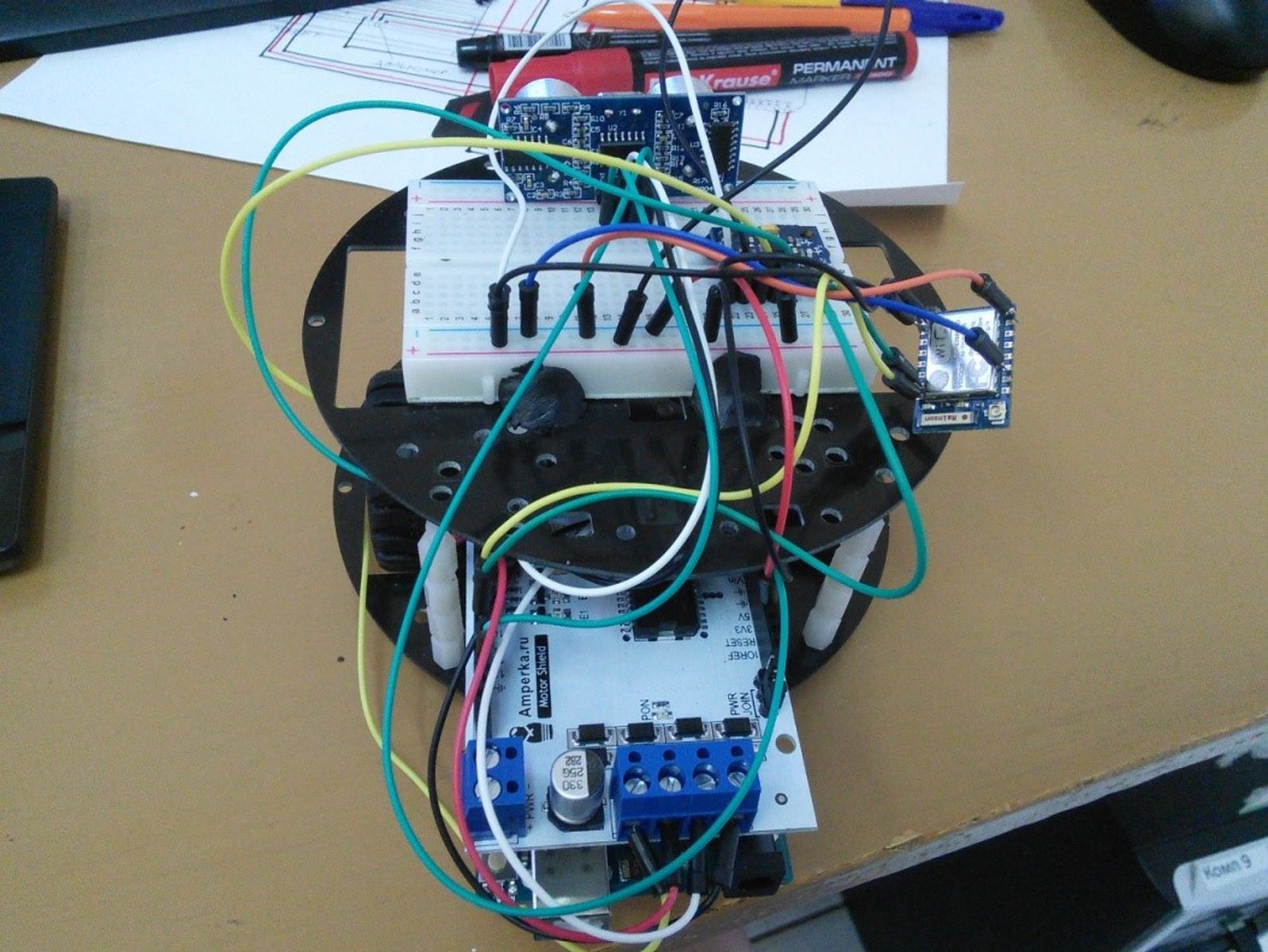
The task of this project was, first of all, to launch esp8266 wi-fi module and master the process of working with it, and then link it to the simplest robot, to demonstrate the exchange of data between the tablet and the robot. From the robot to the tablet, data came from the rangefinder and gyroscope installed on the robot's chassis, and from the command tablet to the robot's movement.
5. Avtopoiler plant. Completed: Popova Nurguyana.
This project carried out the applied part of the innovative site. It was within the framework of work on this project that automatic equipment for controlling the automatic irrigation system came into being. Hardcore hand-made as a result looked like this:
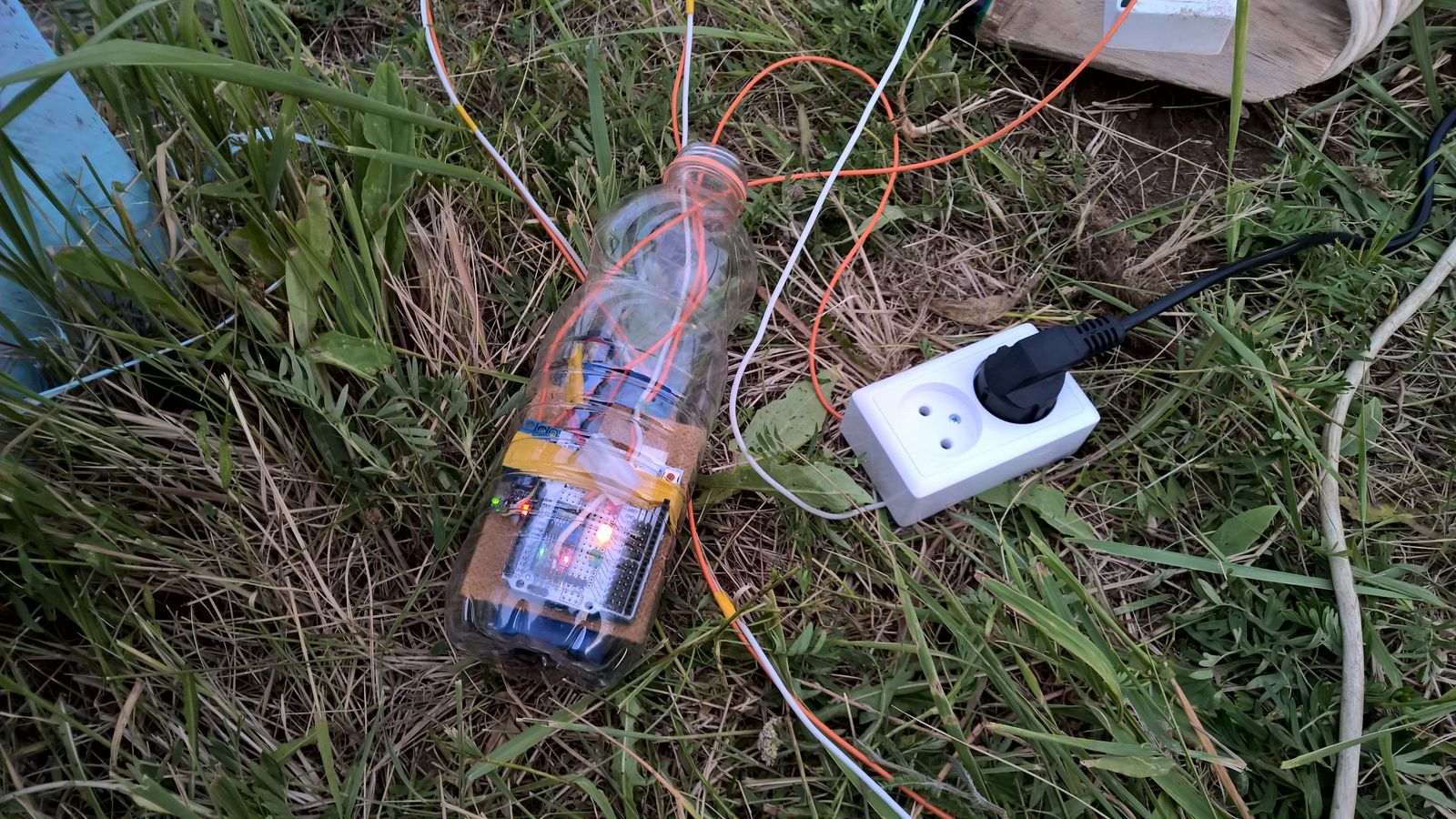
Despite the outstretched line 220V, the arduino board itself and the shield on it were powered by a VEX battery. This was done primarily to minimize the chance of short circuit in the 220V line.
These are the projects involved in the LSIP. But do not think that everyone did what they sat in the classroom from morning till night and pored over their iron. Of course, there was an entertainment program. I will not be able to tell you about all the ventures, since the leaders were involved in organizing events. From what I know were the following leisure activities:
1. On one of the days, a trip of children to the Orto Doydu Zoo was organized, followed by a kebab in nature. Separately, I want to note the fact that despite the remote location of the zoo from the big cities in terms of animals, and by the number of their zoo looks very cool. Camels are particularly striking. Especially in winter. Especially in the cold. Yakutia after all.
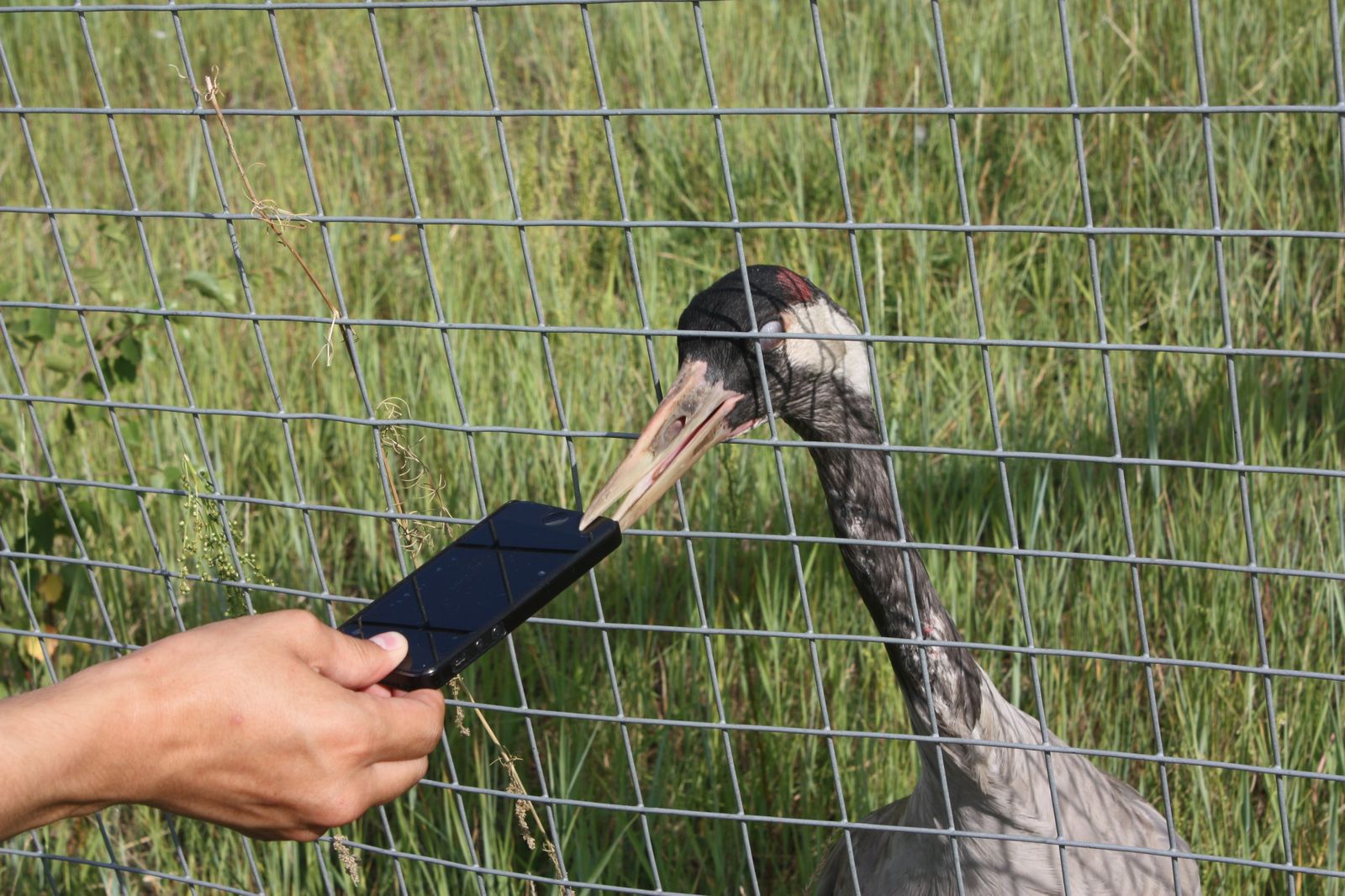
2. Several evenings were devoted to the acquaintance of schoolchildren with modern literature. Such events were organized in the framework of a common idea - 2015 - the Year of Literature. These evenings were held in the library on the basis of the School's 3rd platform - the museum. The head of the library, Kapitonova, N.A., led these evenings. At these evenings, the schoolchildren became acquainted with the current state of literature, works of great importance in art, and also performed poetry reading.

3. One of the evenings was organized large-scale drawing on paper, which then, of course, was transferred to all the painters. I still did not understand what it was, but it looked funny from the outside. And given that the children took part in this venture with great pleasure, they certainly liked it very much.
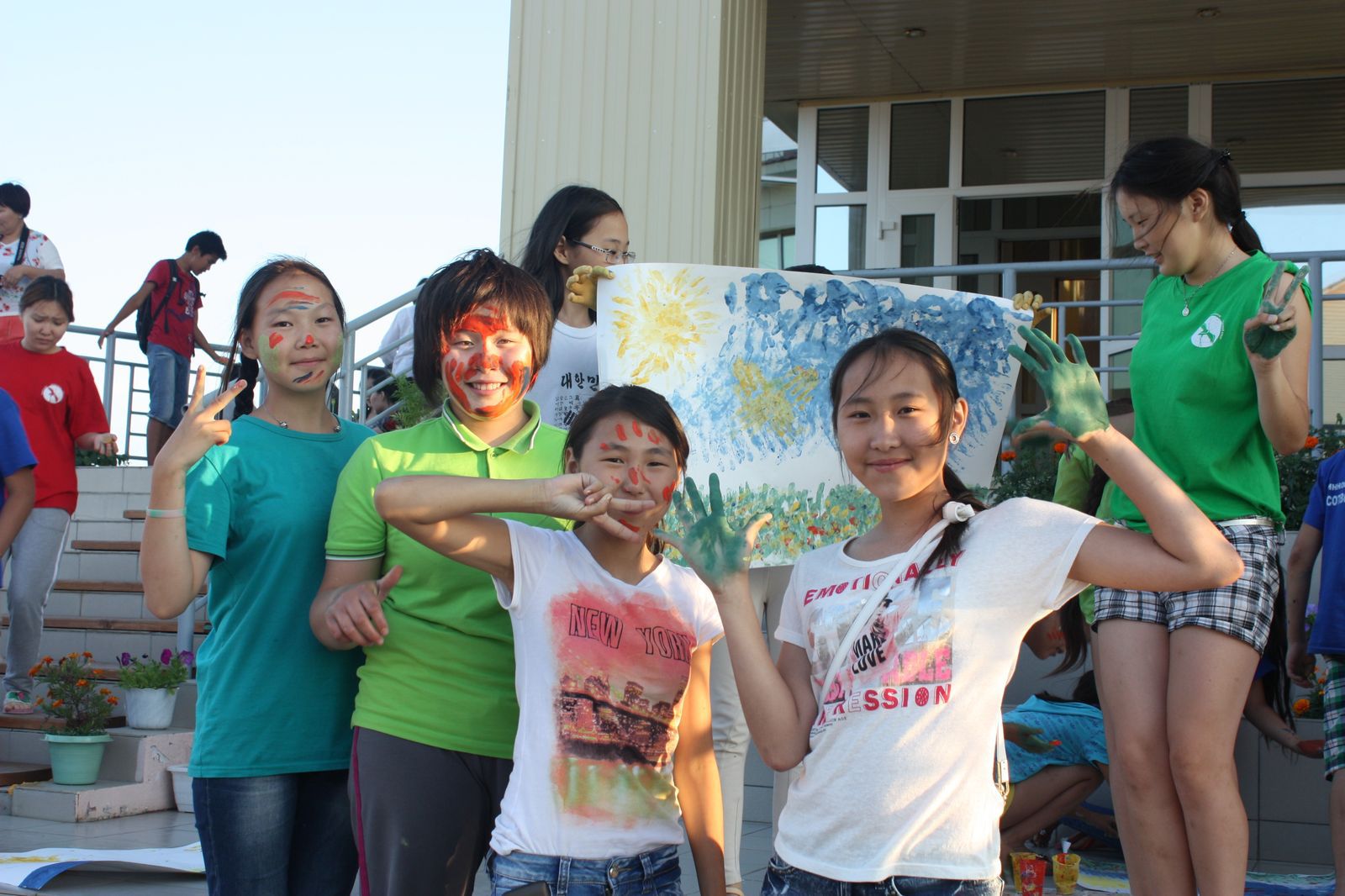
4. One of the most ambitious undertakings, in my opinion, turned out to be an idea with the filming of his film. At the beginning of the School, all the guys divided into several teams and made films throughout the whole school. After that, of course, a film festival was organized with a red ribbon, a premiere show of his creations, and of course, Oscar-winning awards. Everything looked very cool, but the films were in the Yakut language and we understood little ... It's a shame.
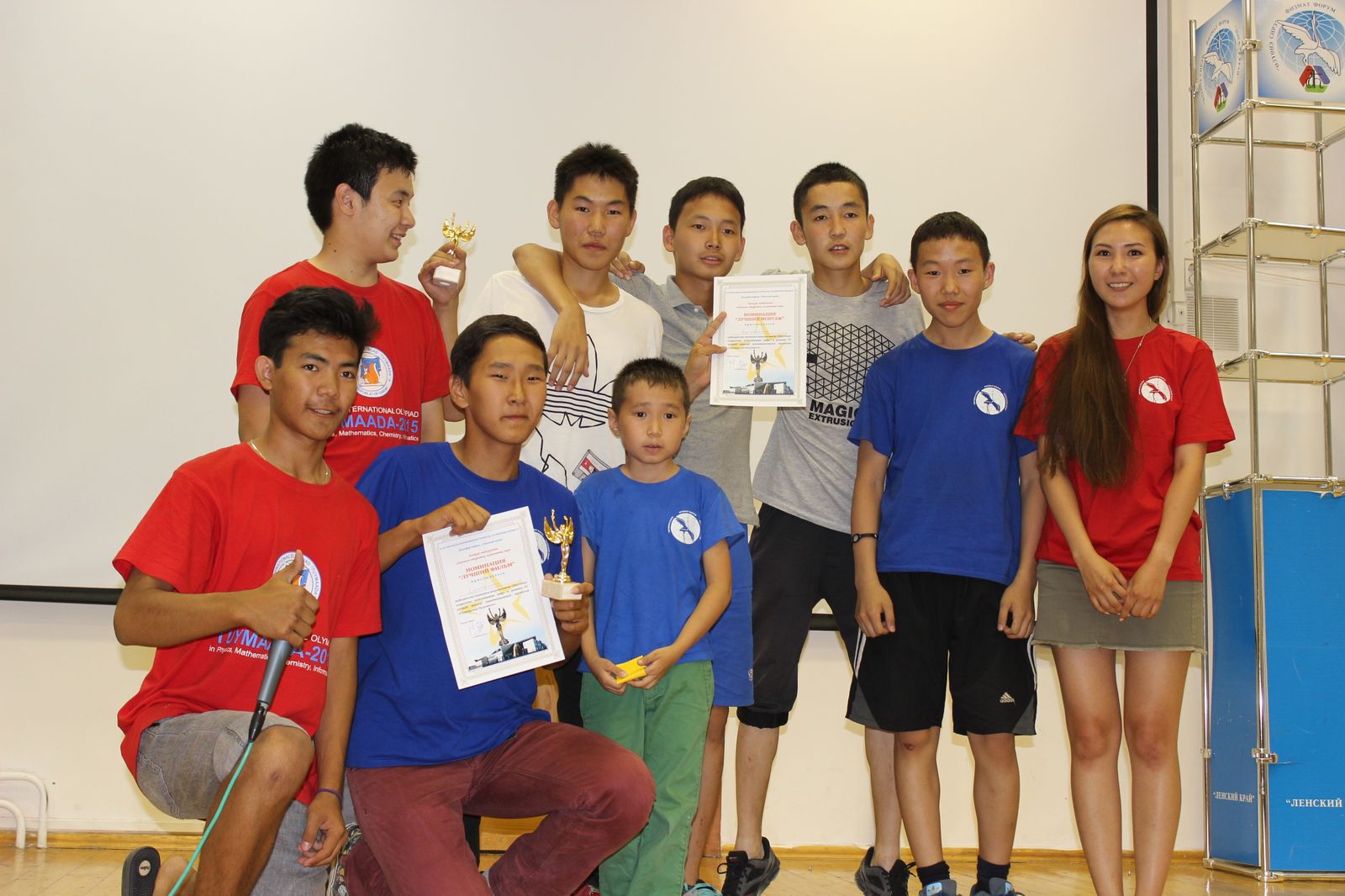
Well, the most ambitious venture was to protect projects and award winners. The defense of the projects consisted of two parts - an exhibition in which the guys presented their working samples and the defense itself, in which presentations of their projects were presented. At the exhibition stage, the jury assessed the degree of complexity of the model presented, its performance and originality. At the protection stage, the relevance of the project, the formulation of goals and objectives, as well as an adequate presentation of the progress of work, were assessed. In addition to everything else, the very process of the presentation was evaluated - how clear, beautiful and logical was the presentation. Since there were a lot of projects, it was decided to separately evaluate junior and senior participants of the School. For each group of estimated distribution of places was as follows: one first place, two second places and three third. Moreover, if the project was done by a group of guys, then the whole group was awarded.
Our youngest winners are:

and the eldest with their leaders:

In addition to the main places, there was also a nomination for the most creative project, which the guys from “physicists” “took”. It is pleasant to boast that our guys from 5 projects took 4 prizes, and from the beginning. Well done!
In addition to working with children, we also held master classes with teachers, as well as two video conferences: one for teachers and school organizers - with CROC representatives, and the other for sharing experience with the robotics school at the Academy of Innovative Processes of Belarus . As part of the latter, the guys exchanged experiences, ideas with their comrades and, most importantly, agreed to hold an online robotics competition. The school completed its work on July 23, 2015, after which we stayed at the Oktemsk Lyceum for 1 day, during which we met with the First President of the Sakha Republic, Nikolayev ME, and discussed the prospects for our cooperation in the framework of educational and industrial robotics, then we went to another School - to the school camp “Uuneeis” (translated from Yakut - Spring) in Amga. .
– , – , , , . , – – , , .., : , 3D .
Getting to this camp was not so easy as we would like ... The lack of a bridge across the Lena River makes use of ferries, which are quite sufficient from Yakutsk, but nevertheless, it does not take much time to cross. Crossing the river, we were in the realm of nature - the forest, the lack of roads in our usual sense, and wild animals running in front of the car ... In general, exotic. Speaking of a car, few cars are able to withstand a trip by what was called an expensive - and oddly enough, our most durable, “loaf” car is the most enduring and enduring car there, and the rest of the park is Japanese right-handed cars. Nothing else survives there. Before the camp we had to drive 200 km, which we overcame in 3 hours. But how extreme it was! Personally, I have long had a strong convictionthat the Yakut drivers drive at a speed of at least 100 km / h, regardless of whether their cars have a road under the wheels or not. To complete the sensations, I rode in the backseat of the “loaf” and felt the beauty of such a ride: ups on bumps, falling in the pits, sharp turns left and right - in general, I can say one thing - after such a ride roller coaster - nothing. Yes, as well as other attractions with ups and downs. For the first hour and a half I was seriously afraid for my life, but then I realized that nothing depends on me personally and I relaxed. Now I understand why Yakuts are such philosophers ... Well, enough of the lyrics.sharp turns left and right - in general, I can say one thing - after such a ride, a roller coaster is nothing. Yes, as well as other attractions with ups and downs. For the first hour and a half I was seriously afraid for my life, but then I realized that nothing depends on me personally and I relaxed. Now I understand why Yakuts are such philosophers ... Well, enough of the lyrics.sharp turns left and right - in general, I can say one thing - after such a ride, a roller coaster is nothing. Yes, as well as other attractions with ups and downs. For the first hour and a half I was seriously afraid for my life, but then I realized that nothing depends on me personally and I relaxed. Now I understand why Yakuts are such philosophers ... Well, enough of the lyrics.
3 , – - , , – « ». , – . , – , – -. – 90 , , . , , , \ . , – 3D . – .
Here is the dining room in the camp:
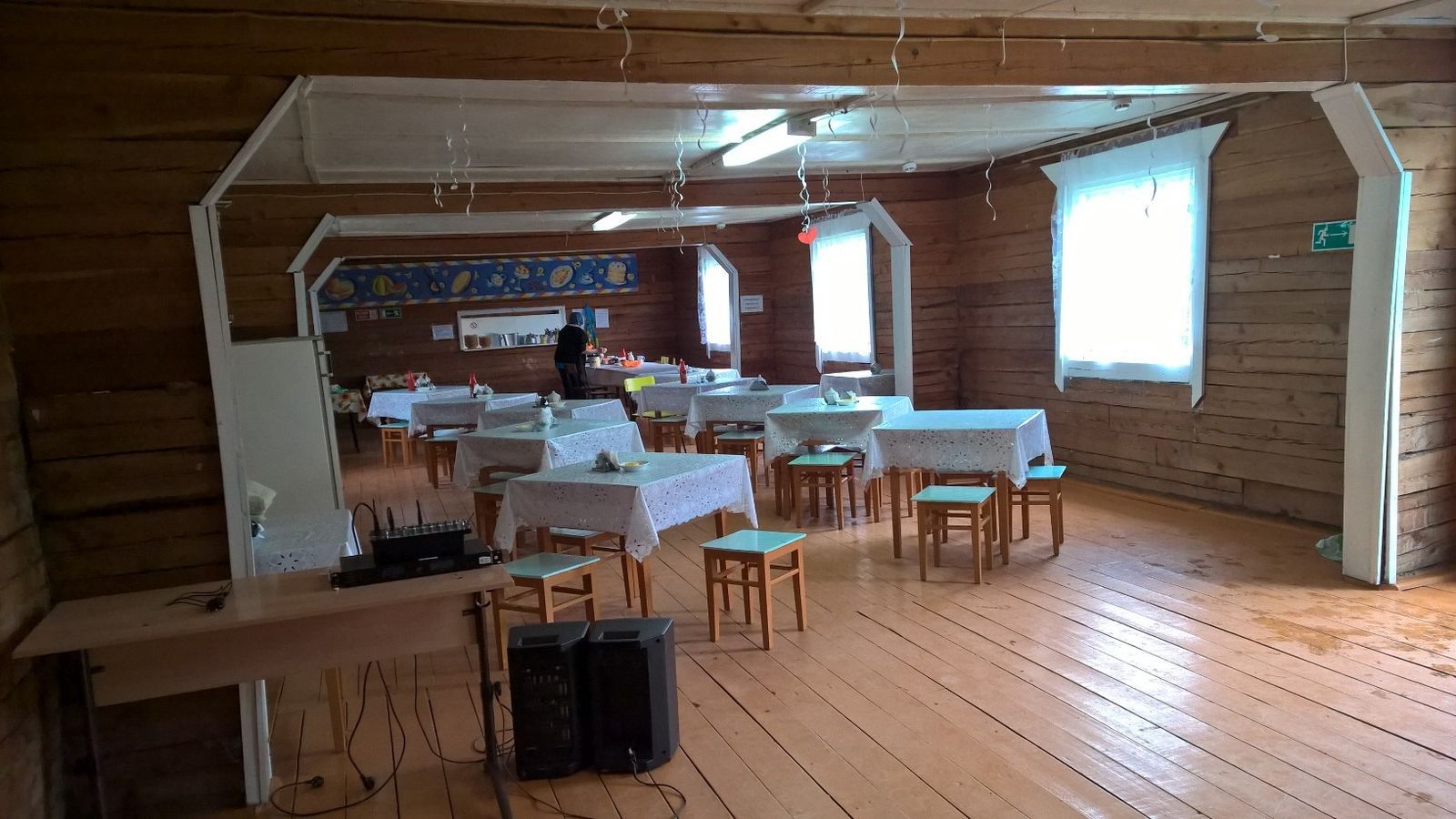
The guys live in the camp for 21 days, i.e. 3 weeks - each of which is allocated for a separate training course. But in our case there was an overlay and with us in the camp was a teacher from Krasnoyarsk, who was supposed to come after us and study physics with the students. However, we were not upset and united our courses - Viktor Mikhailovich read part of the lectures on physics in relation to robotics, Sergei Anatolyevich told about the history of robotics and sensors, and I was responsible for practical exercises. So from a certain point of view, such a unification of courses looked even better, since the questions were considered from all points of view: in physics, the guys got a base and a conceptual apparatus, in lectures they learned how it applies to hardware, and in practical ways they “felt” what was explained to them on the fingers.
Classes were held in small classrooms, which could hardly accommodate everyone, so as for the study space, we should increase it. As you can see in the photos below, these are fairly simple for the finishing of the audience, so the atmosphere of the classes was very colorful.
Classes in physics:
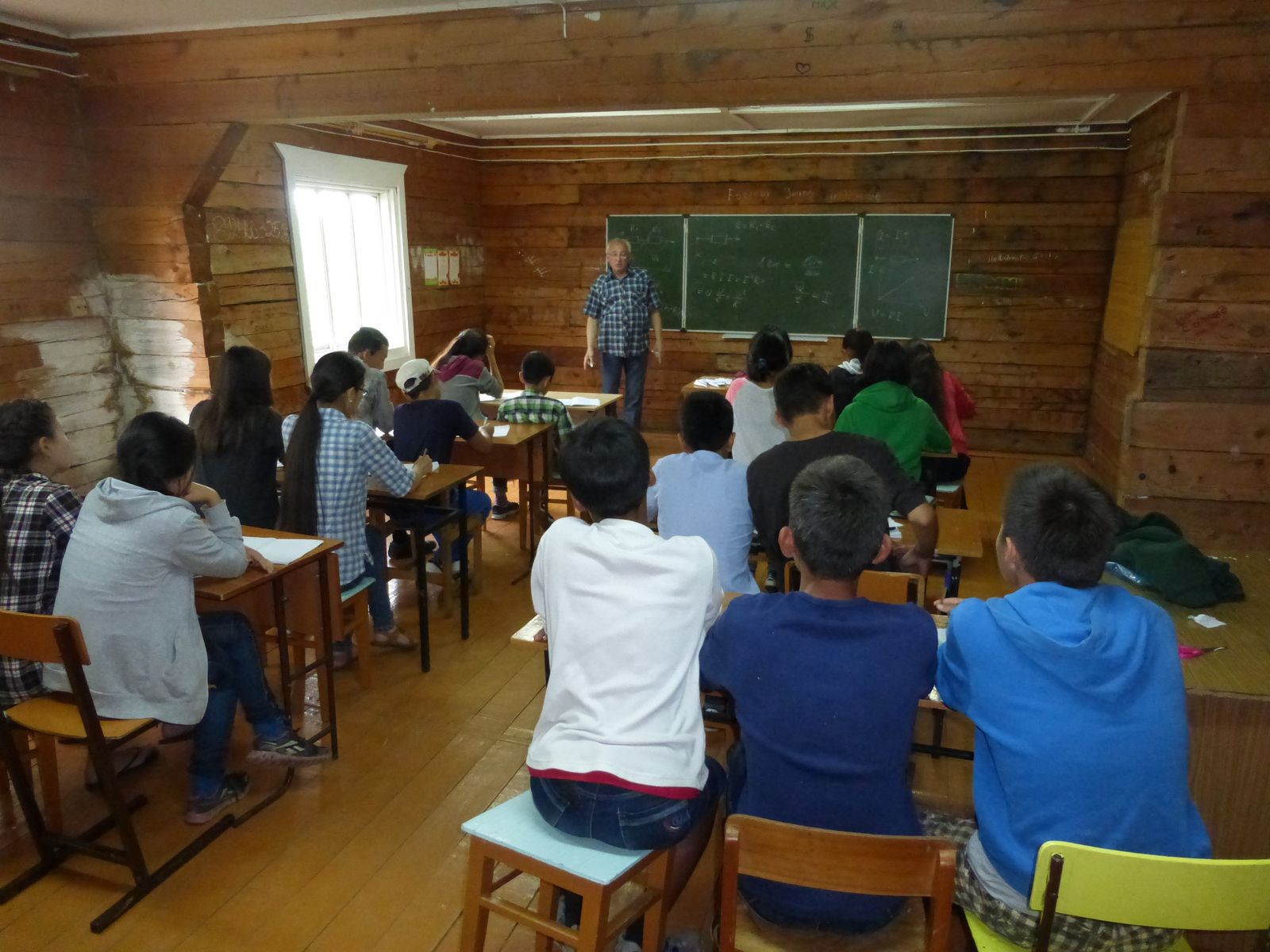
and practice in robotics:
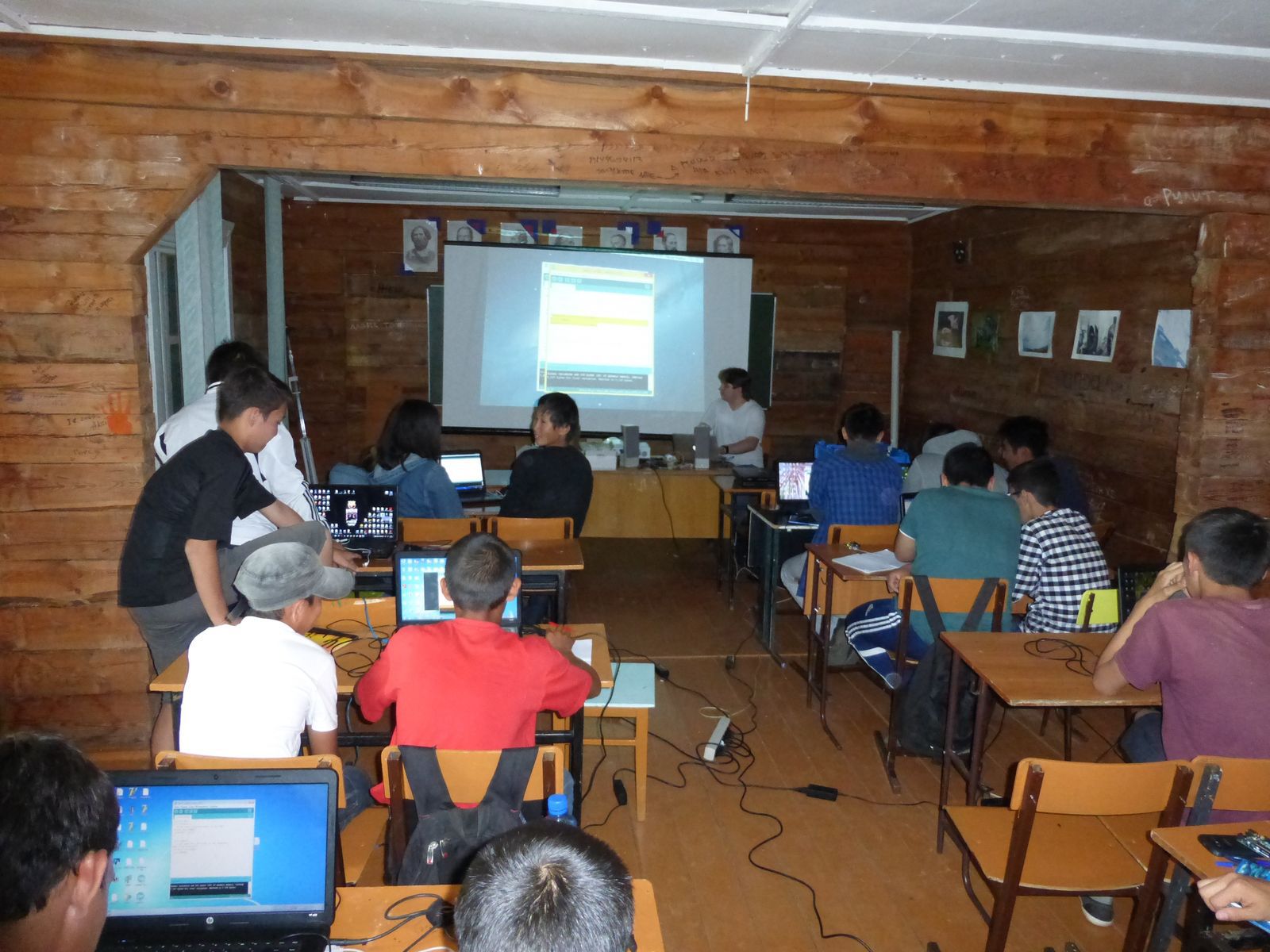
, arduino Vex. , - . , , , , . – , « », « » .. – , .
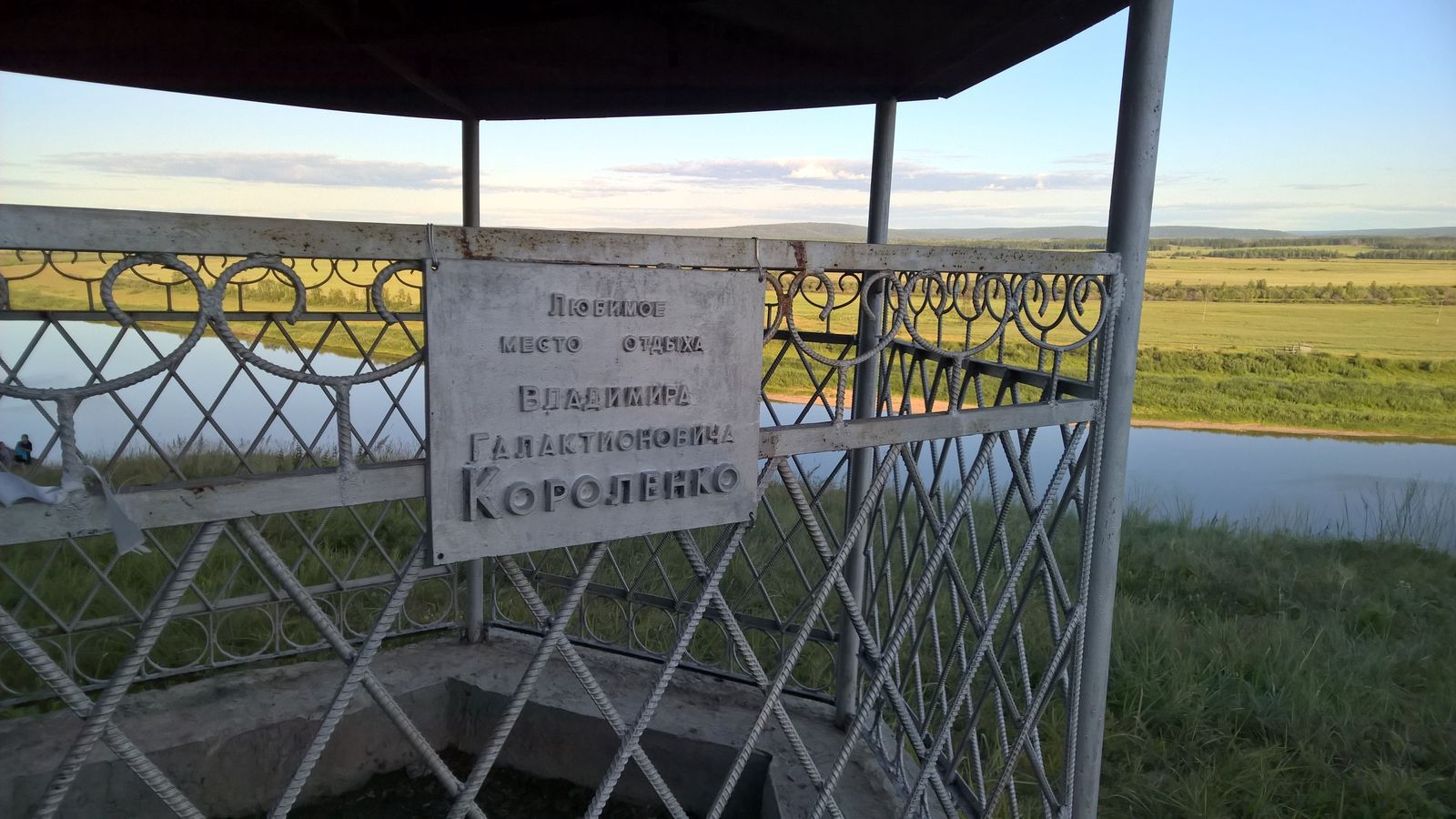
. , .
. 20 6 .
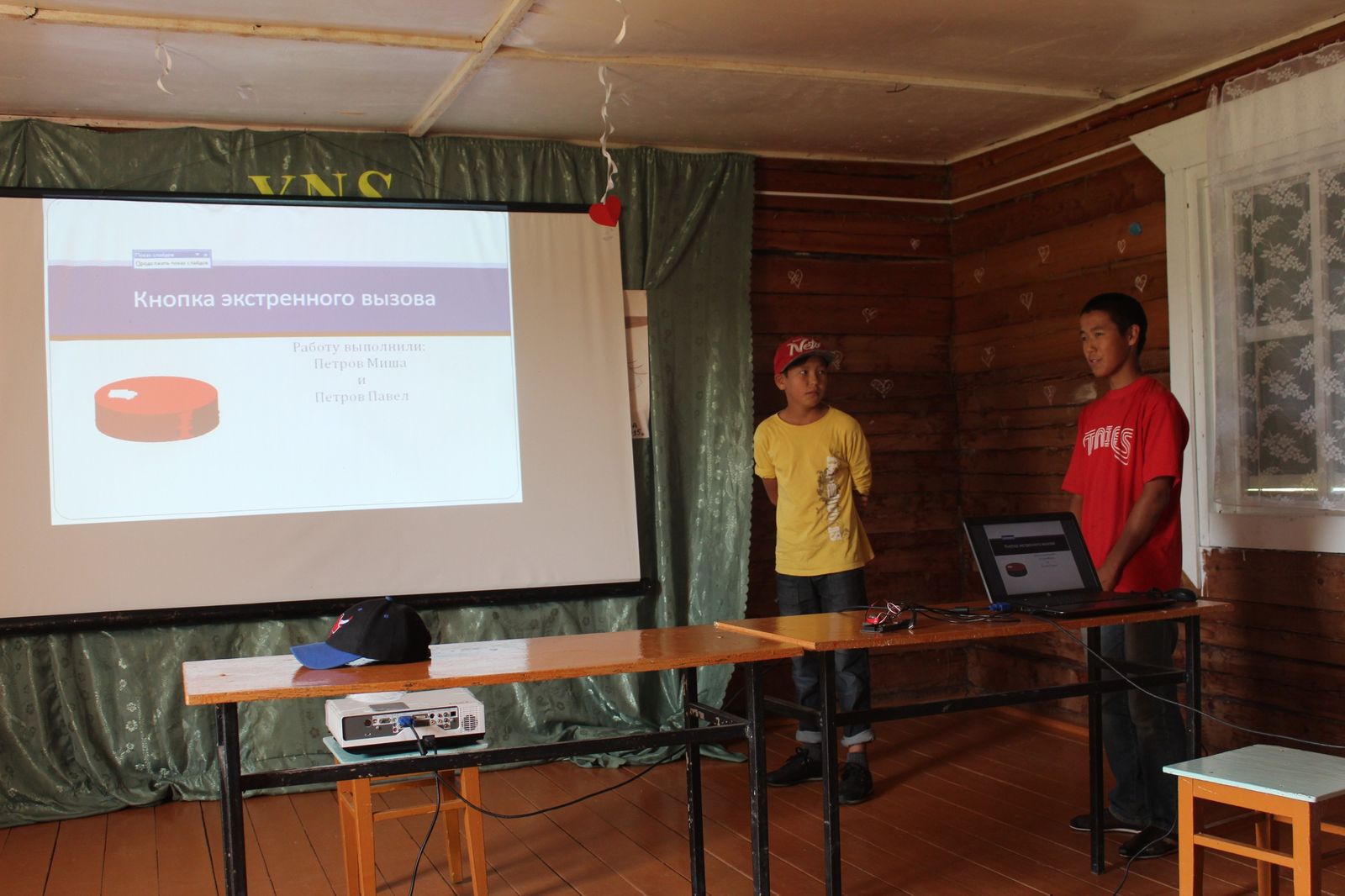
, , , , . , , . !

It so happened that the team of our company is not the first time taking part in the conduct of IT-schools in various parts of our country. Our cooperation with Yakut lyceums and technoparks in the form in which it is proceeding now began last summer with conducting robotics classes at the Summer Physics and Mathematics School “Creating the Future”, which was held at the Lensky Krai forum in the village of Oktemtsy, Khangalassky district. I have already prepared a publication about it and can read it here: Summer School of Innovative Projects “Creating the Future”: how it was .
This year we had the opportunity to participate in the conduct of two schools for robotics in 2 regions of Yakutia: in Khangalassky ulus and Amga. Next, I will tell you how they were organized, who we are and how we relate to these schools. Sit back - we begin.
Summer School of Innovative Projects "Creating the Future"
This school is traditionally held every year in the small homeland of the First President of the Republic of Sakha (Yakutia) - in the village of Oktemtsy of the Khangalassky district. However, until this year, this school was conducted only on the basis of the Lensky Krai forum, which was entirely responsible for the conduct and organization of this school. In the same year, by decree of Nikolaev Mikhail Efimovich, the school was organized right away at 3 sites located in Oktemtsy: at the forum “Lena Krai”, based on the technopark of Oktemsky lyceum and with the support of the funds of the library of the republican museum of the First President of the Republic - Nikolaev M. Since this year we were invited not by the forum, but by the Oktemsky technopark, and worked mainly in it, I will most fully describe what happened in the technopark, but I will also try to highlight the events occurring in the remaining areas School culture beds, but what I can delete or highlight not quite the way it was in fact, so I apologize in advance for that.
A little about us and why we are so good :)
This year, 2 people drove us to the summer schools: the research manager of the RobotGeeks company, he is the associate professor of the Robotic Systems and Mechatronics department at the Bauman Moscow State Technical University — Vorotnikov Sergey Anatolyevich, and I, the author of this publication, Panfilov Alexey Olegovich. The two of us, not the first time working in tandem, achieved quite good results, primarily due to a real understanding of each other's capabilities and skills - S. Vorotnikov. I was primarily engaged in methodological work, reading theoretical lectures and leading the research part of the projects being carried out, and I was responsible for all the technical part and practical training. Everything was as usual here. Our coordinator at the School was Alekseeva Marina Petrovna - the head of the Oktem technopark and just a wonderful person.

Our top top team
')
How it all began and arranged.
I described my feelings about the state of the central part of Yakutia and the roads along which we had to get to the School venue in the first article. I haven’t yet seen anything new on this summer visit. But this is only for now. This year’s accommodation, unlike the previous year, was carried out in a lyceum hotel, which corresponds to about 3 stars in level, which for us, not very spoiled by Muscovites, was pleasant, but not very necessary (last time we lived in a shared hostel for students, which, by the way is much better than typical student hostels of Moscow). Food for us throughout the School was carried out on the basis of the Lyceum's boarding school, where students of the lyceum live throughout the year, but on a strict schedule - 8.00 - breakfast, 13.00 - lunch, 18.00 - dinner, 21.30 - late dinner. The feeding level was quite decent. We were pleased. I would like to separately note the fact that the entire contingent of participants was conditionally divided into 2 parts: "forum" and "lyceum", which resulted in a certain disunity in terms of organization, which in turn affected the division in terms of accommodation of participants and organization of their meals . "Lyceum" lived in a lyceum boarding school and ate there, "forum" lived in a forum hostel, and ate in a forum canteen. Such a division of participants contributed to the division into specializations, primarily focusing on areas of interest to the lyceum, however, as practice has shown, the coordination of issues relating to the organization of the educational and everyday process caused difficulties, but since MP Alekseeva dealt with these issues. they weren’t very worried about us, but until such time as this disunity did not affect our educational process. First of all, this influence was exerted by the lack of discipline at events common to all: the children roared, walked back and forth, generally doing everything they wanted, just not what they had to do. Having expressed our dissatisfaction with the lack of organization in terms of discipline, we were surprised to find the division of forum and lyceum organizers into 2 sides: forum ones believed that everything was normal, but lyceum tried to fix something. In general, as usual, a consensus could not be reached, well, okay. As I have already said, we worked mainly in a technopark, where everything was fine with discipline, and we could endure one-off events for all.
What did the children at school do?
First, a little about the children. Since LSIP has the status of a republican school, children gathered for it from all over the republic and even from Yakutsk itself. In total, more than 70 schoolchildren from the 4th to the 11th grade participated in the School this year. So the contingent was very diverse. As I said earlier, this year 3 sites were immediately involved in which school events were held. Also, the integration of forum resources and technopark resources in terms of technical equipment and the territory made it possible to organize as many as 7 directions in which children could engage. However, since the contingent was motley, within certain directions, there was a division into conditional subgroups, thus allowing the guys with different levels of training to do what was interesting to them. As a result, 10 groups were organized, each of which involved a separate teacher or 2 teachers at once, for example, as in our case. Heads of directions were invited mainly from leading schools and universities of Yakutia, therefore students were engaged with some groups. Since the main condition for studying at the School was to protect their own project (protection was allowed in small groups), within each group the children were divided into subgroups to carry out their project. But there were those who carried out their project alone. Now I will tell you more about each of the directions.
1. Designing Android applications.
As part of this direction, participants were offered to get acquainted with the Android Studio environment, to try to program on JS, and as a result to go out with their application to protect. Classes with schoolchildren were conducted by V.N. Pesterev, a student at the Institute of Physics and Technology at NEFU, and Borisov, V., a researcher at the Institute at NEFU. As part of this direction, 5 projects were completed - in fact, 5 simple applications were written, the most interesting of which, in my opinion, were the GPS tracker, and the game Right-Wrong.
2. 3D modeling
The students who chose this direction were trained to work in 3D Max, and again the direction was divided into 2 groups, with which Yakovlev AV, the computer science teacher from the Yakutsk Cadet School, and Petrova EA, the senior teacher of the Institute of NEFU, were engaged.

In this area, the guys have implemented a number of their ideas, which consist in modeling various objects and structures. From my point of view, despite the fact that some models looked very cool (for example, a tank model with very cool details), all projects clearly lacked an idea why and why these models are being made. Therefore, it is difficult to call what students did the project activity in the classical sense of the word “project”. As a result, this turned out to be a good master class in teaching Mah's work in 3D, but not as managing his project.
3. Designing is not the basis of unusual laws of physics.
Despite the not quite clear name, the essence of the work in this direction was reduced to experimental physics / chemistry, in the framework of which the guys conducted a series of experiments and suggested creative ideas for applying some interesting properties of unusual materials in our life. The result of the work of this direction were 4 projects:
- Clear evidence of harm Coca Cola

- Production of electricity using water flow forces
- Architectural bionics
- Non-Newtonian liquid to cover road holes.
The head of all these projects was Sharaborin E.L. from Moscow Physics and Technology Institute.

4. Lego Mindstorms
Well, where in our time of development of educational robotics without Lego. In this direction, the youngest participants of the School mostly rushed, but there were also enough older ones. All the projects implemented in this direction were fairly typical for Leg'ovskiy kits - either something is going somewhere slowly, or something is standing still and moving.

This time they were supervised by Sveshnikova L.M., a computer science teacher from NGL and Prokopyev EV, a computer science teacher from Ozhulunskaya Secondary School. From my point of view, the only non-trivial project presented in this direction was the project of smart housing lighting, primarily because within its framework an unconventional look at the Lego designers was made. It is a pity that such a solution can only act as a model, when, as the implementation of such a project on arduino, would bring a much greater profit.
5. Creative Robotics + English
The most exotic direction of all. First of all, thanks to his supervisor - the local African American Michael. The youngest members of the School in this area studied English, made simple robots and filmed a film with their participation. It all looked very unusual, entertaining and very exotic.

6. Innovative site
The idea of an innovative site was born in the spring, when the spring irrigation school of robotics was implemented the project of an automatic irrigation system on the arduino hardware platform. At this summer school, it was decided to try to implement this project in real life and use it for automatic watering of flowerbeds with flowers, broken near the school technopark.

7. Design of autonomous robotic systems
The most "adult" and the most serious direction in the framework of the School. Only iron, only hardcore. The smell of rosin and burned components. Of the participants - only students 10-11th classes. From the equipment - all they could find. And we found a lot: 3 VEX constructors, 4 Bioloid Stem sets, 1 Bioloid Premium , a bunch of Arduino hardware platforms, an uncountable number of different sensors and modules for arduino and, of course, electrical tape. It is a pity that not blue. And all this wealth for 5 people. Yes, we had a total of 5 participants and each made their own individual project.

Since the 3rd participants are not the first time they attend our schools of robotics in Yakutia, I ventured to allow everyone to work separately from each other and with full immersion. Full immersion was expressed in the following:
- Separate, the largest audience of the Okteme technopark was allocated to us. We did not bother about the working space - used the place as much as we needed.
- Work began at 9.30 am every day and ended at 6 pm. Lunch break - 1.5 hours. Those interested also came to work out after dinner in addition - from 19.00 to 21-22 hours. And so for 7 days in a row.
- Despite the fact that in Yakutia, in principle, with the trouble of the Internet, we had organized access to the Internet at speeds up to 128 Kb / s.
In general, the conditions for work were gorgeous. And all this resulted in 5 completed projects:
1. Multicomponent mechatronic system with elements of technical vision. Completed: Kapitonov Maria

In fact, this is a robotic arm assembled from Dynamixel servo drives from the Bioloid Premium designer. A feature of the project is the presence of the image recognition module HaViMo2.0, capable of recognizing hand gestures that it sees. As an example, a stone-paper-scissors game was demonstrated, in which the robot won with about 70-80% probability.
2. Two-component system of access control to the protected premises. Fulfilled: Leonid Kondratiev
Using an RFID reader, a laser module, a pair of servo drives and a handful of LEDs, Leonid using a hardware platform Arduino made a door model with a two-component access control system, and writing a script for which the object has / does not have the right to pass through the door, it’s very effective like in the movies". The very layout of the door was assembled from elements of the VEX designer.


3. Robot firefighter. Fulfilled: Ushnitsky Daniel

Using one of the simplest and most affordable VEX-CLAWBOT kits, Daniel made a firefighter robot able to analyze the surrounding air for smoke, if smoke is detected, go on a search for fire and extinguish it with a micropump if it is detected using the available water supply.
4. Control the robot via Wi-Fi. Fulfilled: Kipriyanov Glory.

The task of this project was, first of all, to launch esp8266 wi-fi module and master the process of working with it, and then link it to the simplest robot, to demonstrate the exchange of data between the tablet and the robot. From the robot to the tablet, data came from the rangefinder and gyroscope installed on the robot's chassis, and from the command tablet to the robot's movement.
5. Avtopoiler plant. Completed: Popova Nurguyana.
This project carried out the applied part of the innovative site. It was within the framework of work on this project that automatic equipment for controlling the automatic irrigation system came into being. Hardcore hand-made as a result looked like this:

Despite the outstretched line 220V, the arduino board itself and the shield on it were powered by a VEX battery. This was done primarily to minimize the chance of short circuit in the 220V line.
These are the projects involved in the LSIP. But do not think that everyone did what they sat in the classroom from morning till night and pored over their iron. Of course, there was an entertainment program. I will not be able to tell you about all the ventures, since the leaders were involved in organizing events. From what I know were the following leisure activities:
1. On one of the days, a trip of children to the Orto Doydu Zoo was organized, followed by a kebab in nature. Separately, I want to note the fact that despite the remote location of the zoo from the big cities in terms of animals, and by the number of their zoo looks very cool. Camels are particularly striking. Especially in winter. Especially in the cold. Yakutia after all.

2. Several evenings were devoted to the acquaintance of schoolchildren with modern literature. Such events were organized in the framework of a common idea - 2015 - the Year of Literature. These evenings were held in the library on the basis of the School's 3rd platform - the museum. The head of the library, Kapitonova, N.A., led these evenings. At these evenings, the schoolchildren became acquainted with the current state of literature, works of great importance in art, and also performed poetry reading.

3. One of the evenings was organized large-scale drawing on paper, which then, of course, was transferred to all the painters. I still did not understand what it was, but it looked funny from the outside. And given that the children took part in this venture with great pleasure, they certainly liked it very much.

4. One of the most ambitious undertakings, in my opinion, turned out to be an idea with the filming of his film. At the beginning of the School, all the guys divided into several teams and made films throughout the whole school. After that, of course, a film festival was organized with a red ribbon, a premiere show of his creations, and of course, Oscar-winning awards. Everything looked very cool, but the films were in the Yakut language and we understood little ... It's a shame.

Well, the most ambitious venture was to protect projects and award winners. The defense of the projects consisted of two parts - an exhibition in which the guys presented their working samples and the defense itself, in which presentations of their projects were presented. At the exhibition stage, the jury assessed the degree of complexity of the model presented, its performance and originality. At the protection stage, the relevance of the project, the formulation of goals and objectives, as well as an adequate presentation of the progress of work, were assessed. In addition to everything else, the very process of the presentation was evaluated - how clear, beautiful and logical was the presentation. Since there were a lot of projects, it was decided to separately evaluate junior and senior participants of the School. For each group of estimated distribution of places was as follows: one first place, two second places and three third. Moreover, if the project was done by a group of guys, then the whole group was awarded.
Our youngest winners are:

and the eldest with their leaders:

In addition to the main places, there was also a nomination for the most creative project, which the guys from “physicists” “took”. It is pleasant to boast that our guys from 5 projects took 4 prizes, and from the beginning. Well done!
In addition to working with children, we also held master classes with teachers, as well as two video conferences: one for teachers and school organizers - with CROC representatives, and the other for sharing experience with the robotics school at the Academy of Innovative Processes of Belarus . As part of the latter, the guys exchanged experiences, ideas with their comrades and, most importantly, agreed to hold an online robotics competition. The school completed its work on July 23, 2015, after which we stayed at the Oktemsk Lyceum for 1 day, during which we met with the First President of the Sakha Republic, Nikolayev ME, and discussed the prospects for our cooperation in the framework of educational and industrial robotics, then we went to another School - to the school camp “Uuneeis” (translated from Yakut - Spring) in Amga. .
-
– , – , , , . , – – , , .., : , 3D .
Getting to this camp was not so easy as we would like ... The lack of a bridge across the Lena River makes use of ferries, which are quite sufficient from Yakutsk, but nevertheless, it does not take much time to cross. Crossing the river, we were in the realm of nature - the forest, the lack of roads in our usual sense, and wild animals running in front of the car ... In general, exotic. Speaking of a car, few cars are able to withstand a trip by what was called an expensive - and oddly enough, our most durable, “loaf” car is the most enduring and enduring car there, and the rest of the park is Japanese right-handed cars. Nothing else survives there. Before the camp we had to drive 200 km, which we overcame in 3 hours. But how extreme it was! Personally, I have long had a strong convictionthat the Yakut drivers drive at a speed of at least 100 km / h, regardless of whether their cars have a road under the wheels or not. To complete the sensations, I rode in the backseat of the “loaf” and felt the beauty of such a ride: ups on bumps, falling in the pits, sharp turns left and right - in general, I can say one thing - after such a ride roller coaster - nothing. Yes, as well as other attractions with ups and downs. For the first hour and a half I was seriously afraid for my life, but then I realized that nothing depends on me personally and I relaxed. Now I understand why Yakuts are such philosophers ... Well, enough of the lyrics.sharp turns left and right - in general, I can say one thing - after such a ride, a roller coaster is nothing. Yes, as well as other attractions with ups and downs. For the first hour and a half I was seriously afraid for my life, but then I realized that nothing depends on me personally and I relaxed. Now I understand why Yakuts are such philosophers ... Well, enough of the lyrics.sharp turns left and right - in general, I can say one thing - after such a ride, a roller coaster is nothing. Yes, as well as other attractions with ups and downs. For the first hour and a half I was seriously afraid for my life, but then I realized that nothing depends on me personally and I relaxed. Now I understand why Yakuts are such philosophers ... Well, enough of the lyrics.
3 , – - , , – « ». , – . , – , – -. – 90 , , . , , , \ . , – 3D . – .
Here is the dining room in the camp:

The guys live in the camp for 21 days, i.e. 3 weeks - each of which is allocated for a separate training course. But in our case there was an overlay and with us in the camp was a teacher from Krasnoyarsk, who was supposed to come after us and study physics with the students. However, we were not upset and united our courses - Viktor Mikhailovich read part of the lectures on physics in relation to robotics, Sergei Anatolyevich told about the history of robotics and sensors, and I was responsible for practical exercises. So from a certain point of view, such a unification of courses looked even better, since the questions were considered from all points of view: in physics, the guys got a base and a conceptual apparatus, in lectures they learned how it applies to hardware, and in practical ways they “felt” what was explained to them on the fingers.
Classes were held in small classrooms, which could hardly accommodate everyone, so as for the study space, we should increase it. As you can see in the photos below, these are fairly simple for the finishing of the audience, so the atmosphere of the classes was very colorful.
Classes in physics:

and practice in robotics:

, arduino Vex. , - . , , , , . – , « », « » .. – , .

. , .
. 20 6 .

, , , , . , , . !
Source: https://habr.com/ru/post/294834/
All Articles